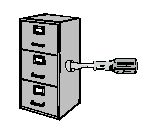
Top rated FoxPro/dBase file repair utility - FoxPro Advisor, Sept. '97 issue. Version 4.0b includes latest Visual Foxpro 9 field repair. |
       
|
Abri Technologies Recover Utility Questions and Answers
Detail instructions are found in the "manual.txt" file that comes with Recover software and is also included with the free demo on our website. Or Download Version 4.0b Recover manual, Download Rebuild utility instructions.
How does Recover compare to other repair software?
Repairing tables over 2GB limit
What record (DBF) file damage can Recover repair?
Garbage in records and record offsets:
What memo file and memo pointer damage can Recover repair?
Memo Pointer Corruption and Memo File offsets:
What are error detection capabilities of Recover?
Record file error detection:
Memo Pointer and Memo file error detection:
Important note on record counter error:
Can garbled individual fields or fields that you
regard as having wrong data be restored to their original contents? In spite of claims by some repair utilities to automatically "repair" unwanted binary data in a field, garbled individual fields cannot be restored to original data. There is no way of software knowing what was there originally. The "removal" or "replacement" of binary data with spaces or whatever can actually cause problems. Such an action can change the meaning or value of data with undesirable consequences.
Example 1:
Example 2:
What is the .def file, is it needed and how is it made?
What if I do not have a good empty or backup copy of my file to
make a .def file?
What is the difference between single user and royalty free license?
The single user license is a reduced price license. It comes with an
easy to use selection screen and is intended for the occasional repair
of a specific file by a single user. It uses the same file repair
methods that the royalty free version does but it cannot be placed on
a network or distributed for multiple end users or your customers -
unless a site or appropriate multiple license has been negotiated. It
also cannot be used in programmatic mode as the royalty free version.
How do I batch scan/repair all files in a directory?
What is the Recover "Trace" method?
1) Removal of garbage records and restoration of offset records.
Other methods require manual intervention - editors, etc. - in such cases.
Most other utilities do not even offer ways of restoring records in such cases.
2) Restoration of memo file if memos are offset and restoration of
CORRECT memo pointers for all corresponding memos that still exist in the memo
file.
Some utilities can detect and "delete" illegal memo pointers - memo
pointers that point to nonsense positions within or outside the memo
file -; or "cross linked" memo pointers - two or more memo fields that
bring up the same memo. But actual memo restoration does not take place.
The file is simply structurally corrected.
None of those utilities can detect "WRONG" memo pointers.
The Trace method is the only known repair utility method that can
actually detect and correct "WRONG" pointers.
The Trace method, however, requires additional trace marking in records
and memos and some additional program coding in your app BEFORE file
damage.
What file damages cannot be repaired?
Similarly - except for the Trace method and in a few cases the SPM method
- Recover cannot re-associate lost memo pointers. It can only remove bad
pointers and crosslinks.
Important note: Trace method IS NOT TO BE installed
in initially bad files in order to repair them.
Trace codes must be installed and maintained in
an initially healthy data files with good data.
If trace codes are installed in a file with bad
data that is exactly what will be extracted,
the data that was marked with the trace codes.
Recover Says that the file is OK but....
1.) FoxPro Indicates a "Not a DBF... file" error.
2.) The file has bad memos or garbage records.
Is there a money back guarantee?
In some cases we are contacted by individuals indicating they would purchase
the software
if they are assured it will fix a specific file. This situation requires us to
engage into custom file analysis work without assurance of payment for work done.
Our policy is to charge $60 per file analysis and letting you know the results.
In such cases we are inclined to wave the $60 fee if the customer purchases
a copy of Recover.
|